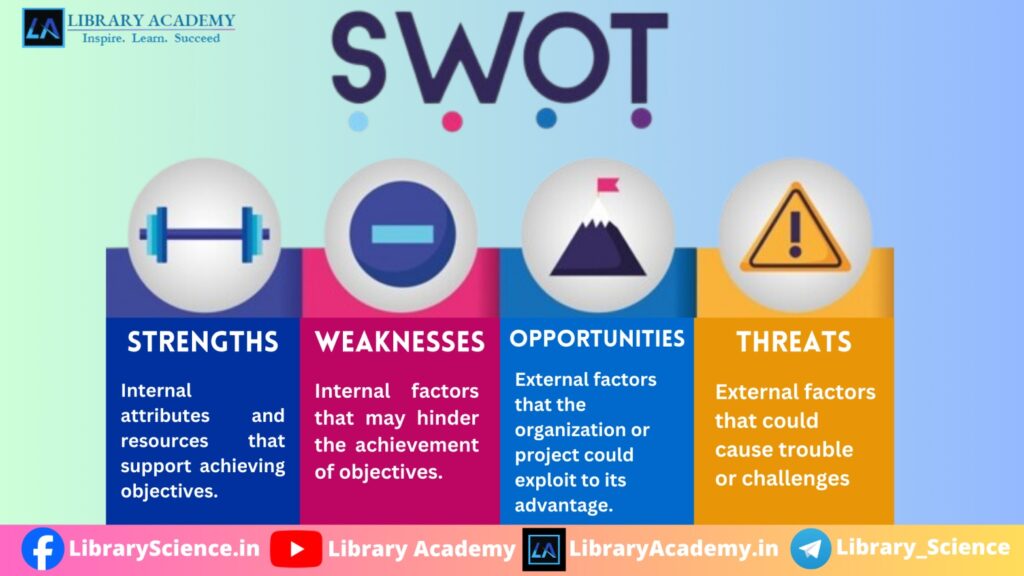SWOT analysis is a strategic planning tool used to identify and evaluate the Strengths, Weaknesses, Opportunities, and Threats related to an organization or project.
SWOT analysis was developed in the early 1960s by Albert Humphrey, a management consultant, during his work at the Stanford Research Institute. Humphrey’s goal was to help organizations identify and assess internal and external factors that could impact their success, thus enabling better strategic planning and decision-making.
Here’s a brief overview:
- Strengths: Internal attributes and resources that support achieving objectives.
- Weaknesses: Internal factors that may hinder the achievement of objectives.
- Opportunities: External factors that the organization or project could exploit to its advantage.
- Threats: External factors that could cause trouble or challenges

A SWOT analysis for libraries can provide a comprehensive view of their current situation and future potential. Here’s a breakdown:
Strengths
- Access to Information: Libraries provide free access to a vast range of resources, including books, journals, and digital media.
- Community Hub: They serve as community centers for education, cultural events, and social interaction.
- Expert Staff: Librarians and staff are trained to help with research and information retrieval.
- Preservation of Knowledge: Libraries play a crucial role in preserving historical documents, manuscripts, and local heritage.
- Technological Integration: Many libraries have adopted modern technologies like e-books, online databases, and digital archives.
Weaknesses
- Funding Constraints: Libraries often face budget cuts and limited financial resources, impacting their ability to expand services.
- Space Limitations: Physical space can be a constraint, limiting the collection size and availability of resources.
- Technology Gaps: Not all libraries are equally equipped with up-to-date technology, which can affect their service quality.
- Staffing Issues: There may be a shortage of trained personnel or a lack of professional development opportunities.
- Underutilization: Some libraries struggle with low patron engagement or outdated perceptions of their relevance.
Opportunities
- Digital Expansion: Embracing digital transformation can enhance access to resources and services, such as online catalogs and virtual reference services.
- Community Partnerships: Collaborating with schools, local businesses, and community organizations can increase relevance and outreach.
- Innovative Programs: Offering new programs and services, such as makerspaces or coding workshops, can attract different demographics.
- Grants and Funding: There are opportunities for securing grants and sponsorships to support library initiatives and infrastructure improvements.
- Advocacy and Awareness: Increased efforts in advocacy can improve public perception and support for libraries.
Threats
- Digital Disruption: The rise of digital media and online resources might reduce the reliance on traditional library services.
- Privacy Concerns: Issues related to data privacy and cybersecurity can affect user trust and library operations.
- Competition: Other institutions or online platforms offering information and learning resources may reduce library patronage.
- Economic Downturns: Economic challenges can lead to reduced funding and financial support for libraries.
- Changing Demographics: Shifts in population and user needs may challenge libraries to adapt quickly and effectively.
This analysis can help libraries identify areas for improvement and develop strategies to leverage their strengths and opportunities while mitigating potential threats.
Frequently Asked Questions (FAQ) and Answers on SWOT Analysis
- What is SWOT analysis?
- SWOT analysis is a strategic planning tool used to identify and evaluate the Strengths, Weaknesses, Opportunities, and Threats related to an organization or project.
- Who developed SWOT analysis and when?
- SWOT analysis was developed by Albert Humphrey in the early 1960s during his work at the Stanford Research Institute.
- What are the four components of SWOT analysis?
- The four components are Strengths, Weaknesses, Opportunities, and Threats.
- What does ‘Strengths’ refer to in a SWOT analysis?
- ‘Strengths’ refer to internal attributes and resources that support achieving the organization’s or project’s objectives.
- What does ‘Weaknesses’ refer to in a SWOT analysis?
- ‘Weaknesses’ refer to internal factors that may hinder the achievement of the organization’s or project’s objectives.
- What are ‘Opportunities’ in the context of SWOT analysis?
- ‘Opportunities’ are external factors that the organization or project could exploit to its advantage.
- What do ‘Threats’ mean in a SWOT analysis?
- ‘Threats’ are external factors that could cause trouble or challenges for the organization or project.
- What are some strengths of libraries identified in the SWOT analysis?
- Libraries’ strengths include access to a wide range of resources, the ability to serve as community hubs, the ability to have expert staff, the ability to preserve knowledge, and the ability to integrate technology.
- What weaknesses do libraries face according to the SWOT analysis?
- Libraries face weaknesses such as funding constraints, space limitations, technology gaps, staffing issues, and underutilization.
- What opportunities are available for libraries based on the SWOT analysis?
- Opportunities for libraries include digital expansion, community partnerships, innovative programs, grants and funding, and increased advocacy and awareness.
 Subscribe YouTube Channel
Subscribe YouTube Channel

